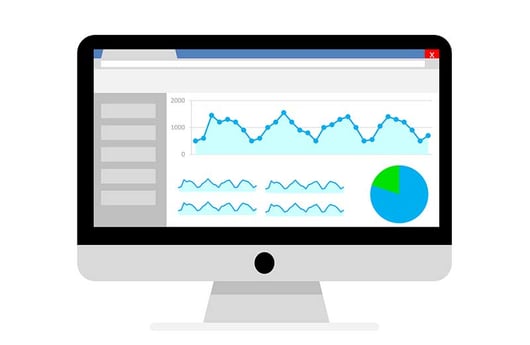A Complete Guide to Understanding Website Analytics


If you are not yet using website analytics to measure the performance of your website, you are missing out on a powerful opportunity to understand your business and the behavior of those who visit it. By monitoring how your current (and potential) customers interact with your site, you can determine ways the overall customer experience can be improved to increase clicks, conversions, leads, and sales.
Warning: website traffic metrics are only as valuable as how they are interpreted. First, you want to have a clear understanding of your website's goals and the buyers' journey, otherwise, website analytics are just a bunch of numbers that are unlikely to provide the insights you need to improve the website and grow your business.
1. Develop a Baseline
Marketing and customer experience expert Jay Baer famously said, “We are surrounded by data but starved for insights.” Nowhere is this more true than in the world of websites (and, more broadly, digital marketing) analytics. There is a ton of data out there, but not everyone is using it.
Before you can begin using website analytics to help you improve your website and, in turn, grow your business, you first have to understand the current state of affairs. You first must develop a baseline of data around the performance of your website. When initially reviewing the analytics, we like to start by understanding what the data is telling us, independent of any goals.
To develop this baseline, we recommend you do the following:
Install an analytics tracking tool
The most popular website analytics tool in use on the web today is Google Analytics. This free tool offered by Google tracks and reports website traffic. This information can help you better understand what your prospective customers are looking for by seeing how much time your audience spends on your site, the specific pages, and how often visitors return to your site.
Review common metrics
Every website owner in the motorsport industry needs to review several essential areas and reports in Google Analytics. These include:
- Audience overview: This is the default report you encounter immediately after logging in to your Google Analytics account and provides insight into the attributes of your website visitors.
- Social network referrals: This report shows all the social networks driving traffic to your website.
- Source/ medium reports: If you want to know the top website traffic sources besides social networks, these reports can help.
- Reverse goal path: Reverse goal path lets you retrace the steps that lead visitors to conversion pages.
- All pages: As the name suggests, this area shows all pages on your website receiving traffic.
Comprehensive reviews will help you identify potential weaknesses and address them accordingly.
Check Traffic Trends Over the Past Two Years
Speaking of traffic, you need to take a closer peek at trends that have manifested over the last two years. These trends can help you determine what content is resonating with users and what content is not. Check to see which pages site visitors linger on, determine the length of time they spend on said pages, and see where they go next.
Do some pages have a high bounce rate? If so, it might be time to review or refresh the content on those pages to make them more relevant to your audience.
Understand Your Users and Where They are Coming From
Every visitor to your website is a potential customer. Where they are coming from and how they got to your site can inform how you can tailor the experience to convert them into customers.
Use your analytics to determine:
- If most of your users are new or returning
- If users are from the targeted geographic region
Suppose you discover that most of your web users are new. In that case, you may need to improve the user experience to encourage site visitors to return. And if most of your visitors are from outside your geographic region, try bolstering local SEO, which will help you generate more valuable leads.
Familiarize Yourself with the Bounce Rate
Sometimes, web visitors view one page and navigate away from your site without taking any action, be it filling out a form, clicking on a link, or making a purchase. The percentage of people that do that is known as the bounce rate.
Understanding your site's bounce rate is paramount in website analytics. Why? This is a quantitative measure of how deeply (or not) website visitors are engaging with your content. A site (or page) with a high bounce is a red flag indicating that content or features need an update to keep prospective customers engaged.
Check Site Speed and Load Times
No one likes poorly performing websites, motorsport enthusiasts and fans included. That is why you must ensure your site has optimum speed and loads as fast as possible.
Don't downplay the role of site speed on your business's performance. Surveys have shown that approximately 70% of customers base their willingness to buy from online retailers on website page speeds.
2. Align Your Business Objectives with Specific Traffic Metrics
Once you develop a baseline understanding of how your site is currently performing, it is then important to consider how your website performance impacts your business. In short, the goals of your website should merely be an extension of your broader business goals.
Start by Reviewing Your Website Goals
If you’re having trouble in this area, start by answering the following questions. :
- Who is your audience?
- What problems are you solving?
- How do you solve said problems?
- Why do you need specific solutions?
Again, these questions are directed ONLY at your website. Yes, the website should be considered, but think about these questions in the context of your business goals. Use the answers to better understand your audience, set targets for your website, and then monitor performance against those goals over time.
A common function of websites is to offer helpful information and lead your prospective customer to your product or service as their solution. A good way to measure how effective the site is at this is through conversions.
CHECK OUT OUR WEBSITE GRADER
Is your website helping, or hurting, your business growth? Grade your site and get recommended improvements in a matter of seconds. Check it out here.
3. Monitor Performance Over Time
Setting a baseline and aligning business objectives with traffic metrics gives you a framework by which you can then monitor the performance of your website (and, in turn, your business) over time.
Monitor those metrics that are aligned with your business goals regularly, and use that data to determine if, and how, your website should be updated to perform better.
How Can We Help You?
If you have questions about your website analytics or how to marry your website’s performance to your broader business growth goals, we can help. Book a call with Chuck today, and let’s chat about how we can help.
